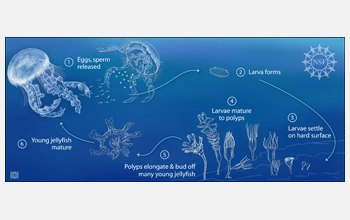Multimedia Gallery
Illustration - Jellyfish Reproductive Cycle
Illustration depicting the reproductive cycle of jellyfish.
Many jellyfish species reproduce extraordinarily quickly. How? By using a peculiar combination of sexual and asexual reproduction involving these steps:
- Eggs and sperm are released by adult jellyfish--sometimes at incredible rates. For example, jellyfish known as sea nettles that live in the Chesapeake Bay may each shed 40,000 eggs daily.
- A jellyfish egg unites with a jellyfish sperm to produce a larva.
- Each larva attaches to a hard surface, such as a rock or an artificial structure like a drilling rig, at the ocean bottom.
- The larva lives as a stationary polyp at the ocean bottom. Although much about polyps--which have only rarely been found in the wild--remains mysterious, scientists suspect that they may simultaneously blanket large expanses of ocean floor. They also suspect that polyps may opportunistically extend their polyp phase from days to even years or decades until conditions, such as temperature and food, are favorable to their survival as adults.
- Once conditions become favorable, each polyp elongates and then buds off and releases many young jellyfish. A single polyp may thereby, by itself, reproduce large numbers of jellyfish. What's more, individual polyps probably don't churn out young jellyfish in isolation. Rather, fields of polyps probably simultaneously transform into veritable jellyfish factories, mass producing tens of thousands of jellyfish at a time. Swarms of young jellyfish may thereby quickly form when their survival prospects are best.
- Each young jellyfish rapidly develops into an adult jellyfish, and the cycle repeats.
To learn more about the basics of jellyfish biology, what scientists have learned thus far about the worldwide increase in jellyfish populations, and the causes of jellyfish swarms and how they affect both human and marine life, see the NSF Special Report, "Jellyfish Gone Wild!" (Date of Image: 2008)
Credit: Zina Deretsky, National Science Foundation
Images and other media in the National Science Foundation Multimedia Gallery are available for use in print and electronic material by NSF employees, members of the media, university staff, teachers and the general public. All media in the gallery are intended for personal, educational and nonprofit/non-commercial use only.
Images credited to the National Science Foundation, a federal agency, are in the public domain. The images were created by employees of the United States Government as part of their official duties or prepared by contractors as "works for hire" for NSF. You may freely use NSF-credited images and, at your discretion, credit NSF with a "Courtesy: National Science Foundation" notation.
Additional information about general usage can be found in Conditions.
Also Available:
Download the high-resolution JPG version of the image. (1.5 MB)
Use your mouse to right-click (Mac users may need to Ctrl-click) the link above and choose the option that will save the file or target to your computer.

